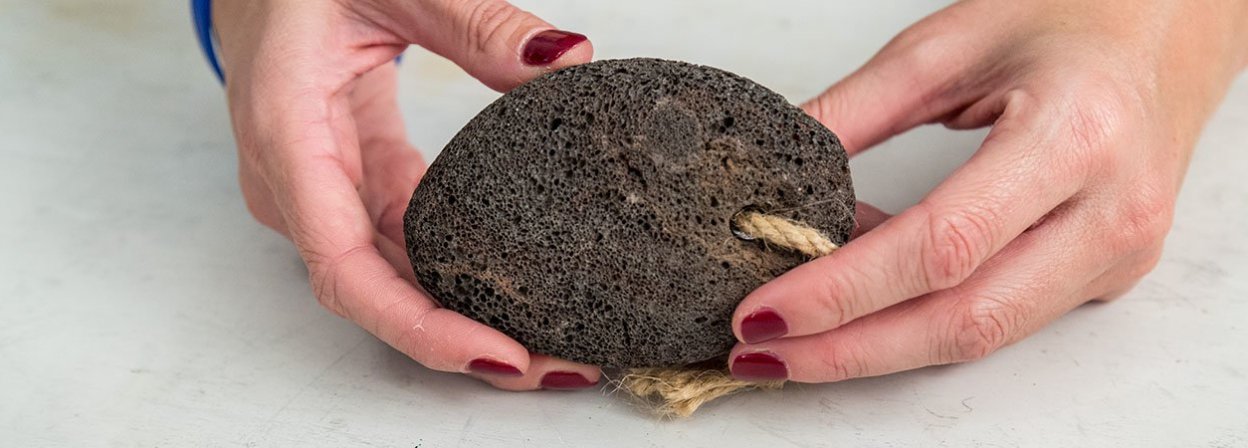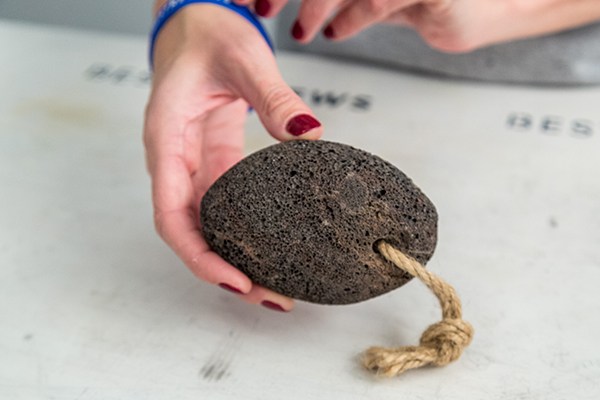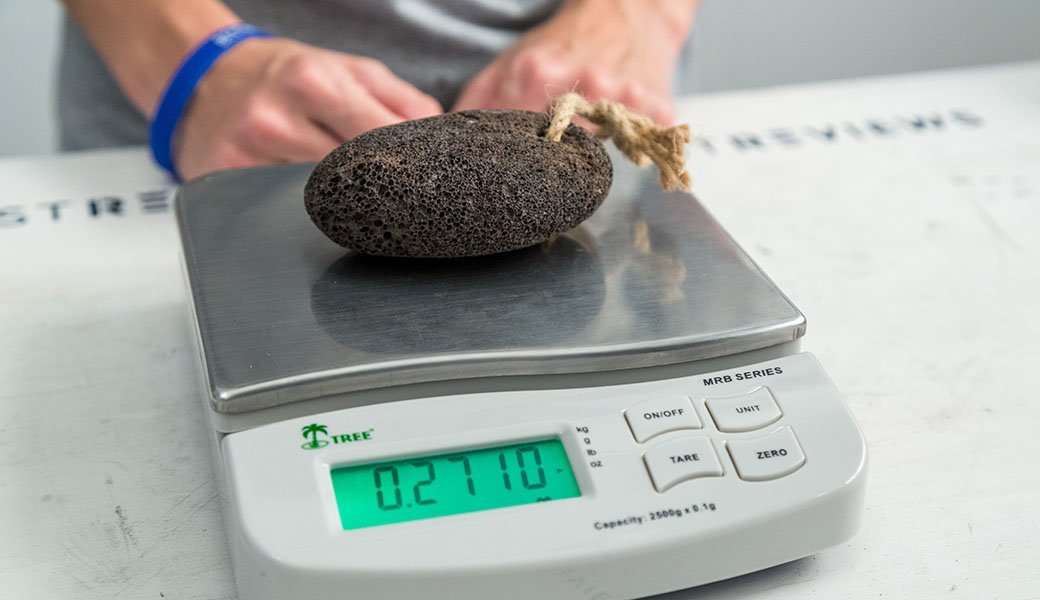When summer rolls around, most of us enjoy wearing sandals and flip-flops, but if you have unsightly calluses or corns, you may feel a little self-conscious about showing off your feet. That’s why having a good pumice stone for your feet can come in so handy – it can help you achieve soft, smooth feet without any pain.
While pumice stones are a fairly simple product, choosing the right one for your particular feet is still important. A pumice stone of the proper material, size, and pore size will be the most effective at removing the hard, dry skin from your feet.

You can use a pumice stone daily, but don’t massage it over your feet for more than five minutes at a time.
PUMICE STONE BASICS
Pumice stone forms when volcanic lava and water mix together and then rapidly cool and harden. The resulting stone is extremely lightweight with a porous texture. The abrasive surface of the stone is just rough enough to buff away hard, dead skin without irritating or injuring your feet.
Many people use pumice stones to improve the look and feel of calluses, which are areas of skin that have become thick and tough due to pressure or friction. A pumice stone can also be helpful for dealing with corns, which are similar to calluses but typically appear on bony areas of the foot like the toes and are often more painful.

HOW TO USE A PUMICE STONE ON YOUR FEET
While a pumice stone can be very effective at removing dead, hardened skin from your feet, you could experience pain if you don’t use the stone properly.
For the most effective exfoliation, soak your feet in warm water for approximately five to ten minutes before you use the pumice stone. If your feet are particularly dry and hard, you can add a moisturizing bath soap or oil to the water as you soak them.
At the same time that you soak your feet, place the pumice stone in warm water to help soften it, too. This will help it glide more easily across the skin.
Using light pressure and circular motions, move the pumice stone over the problem areas on your feet. Don’t buff the same area for more than two or three minutes at a time. When you’ve finished, dry off your feet and apply a moisturizer to help your skin stay soft and smooth.

EXPERT TIP
A pumice stone can also be used to remove dry, rough skin from your elbows and knees.
STAFF
BestReviews
FEATURES TO CONSIDER
Material
All genuine pumice stones for the feet are made from volcanic lava, which means that they’re composed of entirely natural materials. However, some stones are made from synthetic materials that may contain chemicals. To make sure you choose the most effective and healthy pumice stone available, choose one that’s 100% pure or natural.
Size
Pumice stones are available in a variety of sizes. Smaller stones are usually easier to hold and allow you more control over the areas you are exfoliating. With a larger stone, however, you can work more quickly, so your pedicure won’t take as much time.
Keep in mind that because genuine pumice stones are made from natural materials, they can vary in size from stone to stone. No two stones will have the same dimensions.
Shape
When it comes to the shape or design of a pumice stone, you usually have two options: those with a roundish shape and those that feature at least one flat surface. Some people find that rounded stones are easier to rub over the contours of the foot; others prefer a flat stone because they find it easier to apply pressure as needed, especially when it comes to tackling tougher patches of skin.
Handle
Some pumice stones are sold with an attached wooden or plastic handle. You may not have quite as much control over the stone with a handle, but you may find it easier to grip. Many pumice stones don’t have a handle at all; you simply hold the stone and rub it over your skin. Others have a rope tie at the end, which allows you loop it around your hand as you work and also hang it up to dry.
Pore size
Pumice stones are effective at exfoliation thanks to their rough and porous surfaces. However, there is some variation among stones in terms of pore size. Stones with larger pores are rougher, so they’re usually more effective at removing thick, dry skin. Stones with smaller pores are gentler on the skin, which can prevent you from exfoliating too much.
If you’re new to pumice stones and your feet are particularly dry, it’s often best to start with a stone that has larger pores.
Infusion
While most pumice stones feature pure volcanic lava, others infuse the stone with ingredients that can help soften, hydrate, and condition the skin. Many infused pumice stones contain soap, which allows you to clean and exfoliate your feet while you’re in the shower or bath. Some ingredients you may want to look for in infused pumice stones include the following.
-
Shea butter
-
Vitamin E
-
Aloe vera
PUMICE STONE PRICES
Pumice stones vary in price based on whether they feature pure volcanic lava rock or a synthetic material. Stones with a handle or any type of infused ingredients may cost a little more. Regardless of which product you choose, you’ll likely pay between $2 and $23 for a foot pumice stone.
Synthetic pumice stone prices
Synthetic pumice stones without a handle usually run from $2 to $7, while synthetic stones with a handle usually range from $5 to $12. Infused synthetic pumice stones will cost the most of all synthetic varieties – approximately $12 to $17.
Pure pumice stone prices
Pure pumice stones without a handle usually run from $4 to $10, while pure pumice stones with a handle usually range from $10 to $20. Infused pure pumice stones are the priciest variety, usually costing $13 to $23.

To increase the effects of your pumice stone, put on a pair of moisturizing socks after you’ve exfoliated your feet.
FAQ
Q. Are pumice stones really safe?
A. Pumice stones are generally very safe to use on the feet, as long as you use them carefully. While the stones have a rough texture that encourages exfoliation, they’re not sharp, so there’s little risk of them cutting your skin. However, to avoid any scratches, you should always soak your feet in warm water first. It’s also important to wet the stone before you massage it over your feet so it glides smoothly over your skin.
Q. How do you clean a pumice stone?
A. To keep your pumice stone clean, rinse it under warm water after each use to remove any loose skin flakes. Next, wet an old toothbrush with a mixture of warm water and liquid dish soap and brush it all over the stone. Rinse it in warm water again to remove any dirt and other residues.
Since bacteria and fungus are common on the feet, it’s a good idea to periodically boil your pumice stone in a pot of water for five minutes to kill any germs. Make sure the stone is completely dry before you store it.
Q. How do I know when I need a new pumice stone?
A. Your pumice stone will wear down and get smaller in size as you use it. The surface of the stone will also become less porous and less effective at exfoliation over time. When your pumice stone starts to feel smooth, it’s time to get a new one.
https://bestreviews.com/beauty-and-personal-care/foot-care/best-pumice-stones-for-feet